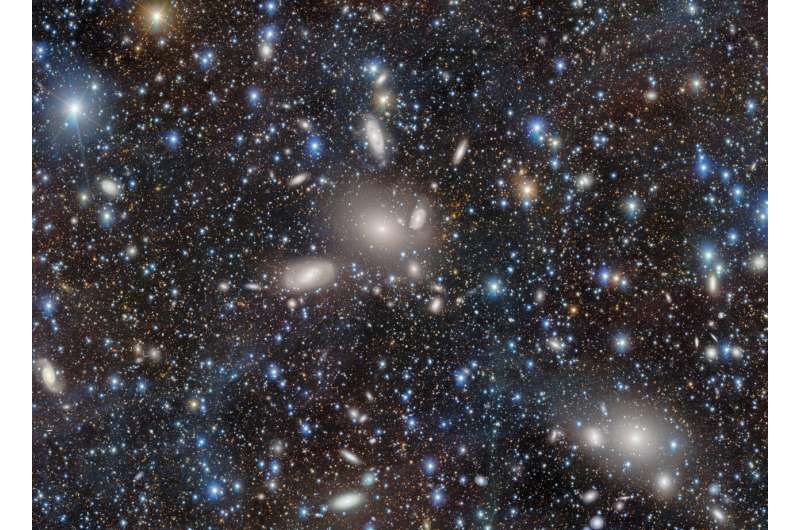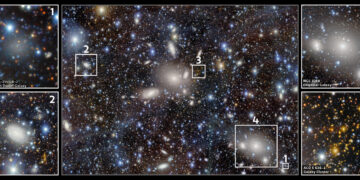The Antlia Cluster, a stunning collection of at least 230 galaxies, lies approximately 130 million light-years from Earth. This cosmic jewel is located in the direction of the constellation Antlia, also known as the Air Pump. Recently, the 570-megapixel Dark Energy Camera (DECam), mounted on the Víctor M. Blanco 4-meter Telescope in Chile, provided a breathtaking ultra-deep image of this cluster.
The Antlia Cluster: A Galactic Wonderland

The Antlia Cluster, formally known as Abell S0636, is among the nearest galaxy clusters to Earth, trailing only the Virgo and Fornax Clusters. Its population includes a rich variety of galaxy types: lenticular galaxies with their distinct disk shapes, irregular galaxies marked by chaotic structures, and ultra-compact dwarfs, which are some of the smallest known galaxies. This diversity makes the Antlia Cluster a treasure trove for astronomers studying galaxy evolution.
Dominating the cluster are two massive elliptical galaxies, NGC 3268 and NGC 3258. These galactic giants sit at the cluster’s core and are surrounded by faint dwarf galaxies. Recent observations suggest that these two ellipticals may be in the process of merging. X-ray data have revealed a ‘rope’ of globular clusters—a formation of tightly packed stars—stretching between them. This discovery points to the possibility that the Antlia Cluster is not a singular structure but rather the result of two smaller clusters coming together.
The Role of DECam: An Astronomical Powerhouse
The Dark Energy Camera (DECam) is one of the most powerful tools in modern astronomy. Developed by the U.S. Department of Energy, DECam was originally designed for the Dark Energy Survey, a project aimed at mapping the universe to uncover the nature of dark energy. With its advanced 570-megapixel sensor and a wide field of view, DECam is capable of capturing faint and distant celestial objects in remarkable detail.
Mounted on the Víctor M. Blanco Telescope at Cerro Tololo Inter-American Observatory in Chile, DECam has been instrumental in producing some of the deepest and most detailed images of the universe. Its ultra-sensitive capabilities allow astronomers to observe low-luminosity features that were previously out of reach. For the Antlia Cluster, DECam’s imaging revealed intricate details of its galaxy population, including diffuse intracluster light—faint glows caused by stars that were flung out during galaxy interactions.
This ability to peer into the depths of galaxy clusters marks a significant step forward in our exploration of cosmic structures. By providing astronomers with ultra-deep images, DECam helps uncover the hidden details of galaxy formation, evolution, and interaction.
The Importance of Studying Galaxy Clusters
Galaxy clusters like the Antlia Cluster are among the largest structures in the universe, forming the backbone of the cosmic web. These massive clusters are not just collections of galaxies; they are intricate systems held together by the gravitational pull of dark matter. Current models suggest that galaxy clusters form hierarchically, with smaller groups merging over time to create larger clusters.
The study of galaxy clusters is crucial for several reasons:
- Understanding Galaxy Evolution: The variety of galaxies within clusters provides a snapshot of different stages in their evolution. Observing interactions, such as mergers and tidal disruptions, helps astronomers understand how galaxies change over time.
- Probing Dark Matter: The gravitational influence of dark matter within clusters affects the motion of galaxies and the distribution of intracluster light. By studying these phenomena, scientists can infer the properties of dark matter, which makes up approximately 25% of the universe.
- Tracing Cosmic History: Clusters serve as cosmic time capsules, preserving evidence of the processes that shaped the universe. Studying their structure and composition reveals insights into the universe’s large-scale dynamics.
In the case of the Antlia Cluster, the merging activity of its dominant elliptical galaxies offers a real-time example of cluster evolution. Observing such interactions provides valuable data for refining theoretical models of galaxy cluster formation.
Insights from DECam’s Observations
The DECam image of the Antlia Cluster showcases a dazzling array of galaxy types and structures. Some key insights from this observation include:
- Variety of Galaxy Types: The cluster hosts not only massive ellipticals but also rarer forms such as ultra-compact dwarfs, compact ellipticals, and blue compact dwarfs. These smaller galaxies are challenging to detect due to their faintness and size, but DECam’s sensitivity makes it possible.
- Intracluster Light: The faint glow of stars flung into the cluster’s gravitational field during galactic interactions is clearly visible. This light provides clues about the cluster’s dynamic history and the distribution of dark matter.
- Merging Activity: The potential merging of NGC 3268 and NGC 3258 highlights the ongoing processes that shape clusters. Such mergers are believed to release vast amounts of energy, influencing the cluster’s overall structure and star formation rates.
Implications for Dark Matter Research
Dark matter remains one of the greatest mysteries in modern physics. Though invisible, its gravitational effects are evident in the motion of galaxies and the behavior of galaxy clusters. Observations of the Antlia Cluster offer a unique opportunity to study dark matter in action.
The distribution of intracluster light and the dynamics of the merging elliptical galaxies suggest that dark matter plays a crucial role in holding the cluster together. By analyzing these features, scientists can test and refine their models of dark matter behavior on large scales. Furthermore, the presence of low-luminosity dwarf galaxies in the cluster provides additional evidence for the influence of dark matter in shaping galactic structures.
Future Prospects: Expanding Our Cosmic Horizon
The success of DECam in capturing the Antlia Cluster sets the stage for even more ambitious astronomical projects. One such initiative is the Legacy Survey of Space and Time (LSST), which will be conducted by the Vera C. Rubin Observatory. Scheduled to begin operations soon, LSST will use a 3.2-gigapixel camera to survey the entire southern sky, capturing detailed images of thousands of galaxy clusters.
The LSST aims to detect intracluster light in unprecedented detail, providing new insights into the distribution of dark matter and the evolutionary history of galaxy clusters. By combining data from DECam and LSST, astronomers will be able to construct a more comprehensive picture of the universe’s largest structures.
Additionally, advancements in observational technology, such as next-generation space telescopes and ground-based observatories, promise to reveal even more about the cosmos. These developments will enable astronomers to probe deeper into the universe’s past, uncovering the secrets of its origin and evolution.
Conclusion: A New Chapter in Cosmic Exploration
The DECam’s capture of the Antlia Cluster is a testament to the power of modern astronomical instruments. By revealing the intricate details of this galaxy cluster, DECam has provided a window into the dynamic processes that shape the universe. From the merging of massive elliptical galaxies to the faint glow of intracluster light, the Antlia Cluster tells a story of cosmic evolution on a grand scale.



















